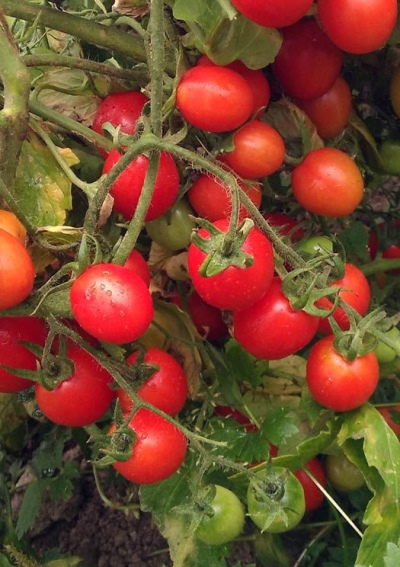
- Authors: Tereshonkova T. A., Klimenko N. N., Kostenko A. N. (Agrofirma Poisk LLC)
- Year of approval: 2009
- Category: grade
- Growth type: indeterminate
- Appointment: fresh consumption, for whole fruit preservation
- Ripening period: early
- Ripening time, days: 90-95
- Growing conditions: for open ground, for film greenhouses
- Bush size: tall
- Bush height, cm: 120-150
Growing delicious tomatoes is the dream of every gardener, but choosing the best from the many types is quite difficult. One of the non-capricious varieties that grows well in open ground, in greenhouse conditions, as well as on a balcony or window is an early tomato variety under the fabulous name Thumbelina.
Breeding history
The nightshade crop was bred by a group of domestic breeders (Kostenko, Klimenko and Tereshonkova) in 2008. The variety is included in the State Register, and also approved for use in 2009. The crop is recommended for cultivation in almost all regions of the country.
Description of the variety
Tomatoes Thumbelina are tall indeterminate bushes, stretching up to 120-150 cm. The plant is characterized by moderate thickening, large leaves of rich green color, strong stems, simple inflorescences and a powerful root system. A carp culture is formed in 2-3 stems, and also requires a mandatory garter to the supports. The variety does not need pinching.
The main qualities of the fruit
Mini-tomatoes, growing in beautiful clusters, attract attention by their diminutive size - the average weight of a tomato is 15-25 grams, and a uniform, red-orange color. At the stage of ripening, the fruits are colored green. A rounded tomato has a dense and smooth skin with a slight gloss. It is the density of the peel that protects against cracking and allows the fruits to be stored for a sufficient time without losing taste.
Taste characteristics
The taste of the Thumbelina fruit is amazing. The taste has a pleasant sweetness and light sourness, which are perfectly complemented by the juiciness and meatiness of the tomato pulp. This variety is universal, so tomatoes are used both fresh and canned. Especially tasty cherry tomatoes are whole-fruit canned.
Ripening and fruiting
Tomatoes Thumbelina belong to the early class. From the moment the first sprouts appear until the tasting period, only 90-95 days pass. The ripening and fruiting dates may shift slightly under the influence of the climatic characteristics of the growing region. Fruits ripen at the same time, so you can pick tomatoes with whole brushes, on which there are up to 15 tomatoes.
Yield
The yield indicators of this variety are high. Observing the rules of agricultural technology, you can collect from 1 m2 to 4.7 kg of fruits. On average, one bush per fruiting season gives up to 4 kg of tomatoes. The harvest peaks in July-August.
The timing of planting seedlings and planting in the ground
Sowing seeds for seedlings is carried out 45-50 days before the expected planting of the bushes in a permanent place of growth. As a rule, sowing is done in mid-March. The seed must be disinfected using a solution of potassium permanganate.
Seeds are sown in pre-prepared soil (sand, garden soil and peat) in boxes. For the early emergence of sprouts, you can provide a greenhouse effect using glass or polyethylene. As soon as shoots appear, the film / glass is removed. Seedlings should grow in a warm room with good lighting. With the appearance of 2-3 true leaves, a dive is carried out into separate pots.
Planting seedlings in a permanent place (open ground or greenhouse) is carried out from mid-May, when night frosts are behind, and the air temperature is above 16-18 degrees.

Growing tomato seedlings is an extremely important process, because it largely depends on whether the gardener will be able to harvest at all. All aspects must be taken into account, from seedbed preparation to planting in the ground.
Landing scheme
On 1m2, it is allowed to plant up to 3-4 bushes of seedlings. The optimal layout for planting is 70x60 cm.

Growing and care
The nightshade crop is grown in fertile, loose, well-breathing soil. As soon as the bush is stretched to 25-30 cm, it is necessary to carry out a garter to a pre-installed support. Complex plant care consists of watering, fertilizing, forming and tying bushes, loosening the soil.




A plant needs different micronutrients at each stage of growth. All fertilizers can be divided into two groups: mineral and organic. Folk remedies are often used: iodine, yeast, bird droppings, eggshells.
It is important to observe the rate and period of feeding. This also applies to folk remedies and organic fertilizers.
Disease and pest resistance
The plant has a high resistance to diseases (alternaria, tobacco mosaic virus, septoria, powdery mildew), however, preventive measures should be carried out regularly.


Resistant to adverse weather conditions
The culture is unpretentious, but the variety is not resistant to sudden temperature changes. In addition, it is recommended to regulate humidity, the excess of which can lead to the formation of numerous stepchildren.
Growing regions
In greenhouse conditions, Thumbelina tomatoes can grow and give good harvests in any region of Russia, Ukraine, Belarus.
Review overview
Mini-tomatoes Thumbelina are a frequent guest on balconies and in greenhouses of summer residents. The variety is loved for its unpretentiousness, incredible taste and yield. Many housewives are captivated by the diminutiveness of tomatoes, which makes it possible to carry out whole-fruit canning.

























































































